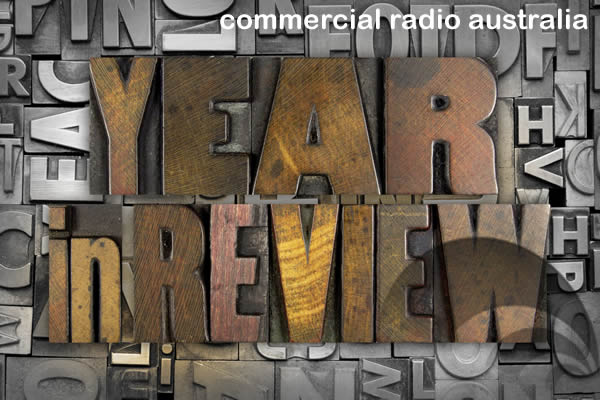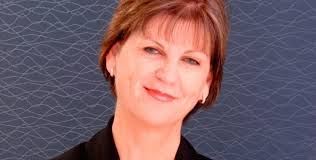Commercial Radio Australia: The Year in Review Part 1

Commercial Radio Australia is headed up by CEO Joan Warner. It’s the industry's peak body.
2014 has been a year of firsts. Amongst the list of achievements: a new Metro survey provider with GfK including new Gold Standard software, New Regional Radio Survey methodology introduced, and we have seen some big increases with Digital Radio listening. But it's not all smooth sailing either, a few challenges lay ahead, be it internet streaming or the rollout of DAB+ to regional markets.
In part one of our chat with Joan, we talk about what CRA actually does, and it’s a lot more than you think. We look at Digital radio and the positive inroads that have been made this year, and we talk about an offer made to smart phone manufacturers that could see them advertised on every commercial station for free.
Blair Sullivan: What is the actual role / charter of CRA for the commercial Industry?
 Joan Warner: Well. We have a multi-faceted charter. We do a lot of things that other industry bodies don’t do.
Joan Warner: Well. We have a multi-faceted charter. We do a lot of things that other industry bodies don’t do.
First and foremost we are a membership organisation, we represent the members on policy and legislative matters to both state and federal governments. We develop and hold the Radio Codes of Practice.
We also hold the master contract for the radio surveys. We also do all the negotiations for all the copyright agreements.
 In addition, we are responsible for marketing and brand strategy for the industry, which at the moment is “Radio, it’s a love thing”.
In addition, we are responsible for marketing and brand strategy for the industry, which at the moment is “Radio, it’s a love thing”.
We are responsible to rollout and continuing rollout of DAB+ Digital Radio in Australia. We also run the major awards and conference events every year.
We run the Siren Creative Awards for agencies and we have a program for country music artists, where we send one to Nashville every year to get some experience in writing. And of course we have our First Break, where we find unsigned artists and we give them airtime on commercial radio for one of their tracks.
Blair Sullivan: So you are not busy at all?
Joan Warner: We do a lot of things. We are not just a lobbying body and we are not just a marketing body and we are not just a research body.
We are actually of all of those things.
And we also commission research to be undertaken to actually underpin our brand strategy, whereas Television for example does the lobbying and the advertising standards. But they don’t do the Logie awards, and they don’t do the research, Oztam does that.
So we sort of do everything.
BS: You touched a little bit on Lobbying just before, how is CRA’s relationship with the government? Are they responding to your concerns?
.jpg) JW: Well, they are not responding as quickly on some as we would like. On others they are willing to listen.
JW: Well, they are not responding as quickly on some as we would like. On others they are willing to listen.
We have had some small changes to some of the more damaging trigger events requirements that the last Liberal Coalition Government brought in.
I don’t know if you remember, but in regional Australia there are 3 hours of mandated local content which is fine, we are not trying to change that, but there was also a bit of a whacky thing called a trigger event, where if any station was sold or even it was owned by a family or share transfer within a family, or if the owner died and the kids inherited – that was called a trigger event.
And that triggered all sorts of conditions. The two worst ones were that you could never change the staffing, never ever and you could never change the production facilities.
So if you were going through a downturn and had to get rid of a part time sales person, you could never do that if you had been through a trigger event. So I have to say the former Labour Government and this Government have added a sunset clause in there, so they only have to keep the same number of staff and production facilities for two years.
So there is that quite a strange requirement in there.
So there are things like that, things around reporting – we have very onerous requirements around reporting and other things. And this government has reduced those on a complaints basis. So it's not just reporting for the sake of reporting. ACMA only steps in if there is a complaint.
There have been some good things on the edges that we have been able to achieve with our current minister, but we still have a couple of major issues that we are talking to him and the rest of the government about.
 BS: DAB+ – some good inroads made this year. For you, what has been the highlight?
BS: DAB+ – some good inroads made this year. For you, what has been the highlight?
JW: I think the highlight is up from 40,000 two years ago, we now have 125,000 cars on the road with DAB+. And that’s a massive increase in just two years and more and more car manufacturers are putting it in as standard. Ford Mondeo announced yesterday that it is coming with DAB+ as standard next year in its new model.
Family car manufacturers are now starting to put it in. Toyota did it two years ago.
So getting it into cars and the rapid uptake in cars, where it’s an option, not just going I don’t want it but actually choosing I want DAB+ broadcast.
I think the fact that we now have three million people listening via DAB+ device and now 23% of all radio listening now in the five capital cities is via DAB+.
So it has been a pretty outstanding couple of years for the uptake of DAB+.
 BS: Are you actually looking at separating the actual ratings numbers for DAB only channels, putting the likes of Buddha or Gorilla radio in to play so we can see how they are performing?
BS: Are you actually looking at separating the actual ratings numbers for DAB only channels, putting the likes of Buddha or Gorilla radio in to play so we can see how they are performing?
JW: We are starting to look at how we might be able to do that. We are not sure what is going to be the most effective way of doing it because there are so many new DAB+ stations, but we are looking at it. The board actually asked us to prepare a paper, so we are hoping sometime early next year or releasing some data quarterly on those DAB+ stations so people can see there is a good niche audience where you can advertise too.
 BS: Now networks can make their own decisions about how they might use their DAB+ channels, but how do you feel about spectrum being used not for listener focused formats but purely for a commercial brand to own.
BS: Now networks can make their own decisions about how they might use their DAB+ channels, but how do you feel about spectrum being used not for listener focused formats but purely for a commercial brand to own.
I guess the one that comes to mind is Nova Entertainment with Coles Radio. Now it’s a good move revenue wise for them, but is that what DAB+ is all about?
JW: Well it can be part of what DAB+ is about, if you listen to Coles Radio it actually has pretty good programming, it just has limited advertisers.
Those stations are designed so that they can be picked up on Free to Air, where there is a DAB+ radio and the content is also acceptable to just the general listener.
I’ve had people say to me they really love the Chemist Warehouse station, they have great health topics, music and it’s really their type of station.
Obviously they are a benefit to Coles as they are sponsoring and they get all the ads, but they are paying for the airtime. But what the stations have done is made sure that those stations which I guess are Private Label you might call them, are actually also going to appeal and be acceptable to general listeners.
 BS: Radio chip for smartphones – when in Australia?
BS: Radio chip for smartphones – when in Australia?
JW: Oh soon we hope. We are working with two international bodies. There is going to be a phone released at a world forum February next year – an LG smartphone, their latest with a DAB+ chip in it.
We are part of a group that is also talking with Samsung as well. I think the trigger has been for the smartphone manufacturers, they are finally talking to radio broadcasters.
We have countries like England, France, Germany, all the Scandinavian countries. All these countries are using the technology.
We have got Thailand starting a massive trial next year. We’ve got Jakarta already running a big trial – so they are starting to see this rollout around the world and of course Australia. But on our own we can’t make it happen.
We are very hopeful that next year we may be able to promote an offering. And we have actually written to the handset manufacturers and said, if you will put a DAB+ chip inside a smartphone, even for just Australia, we will give you free advertising on every commercial station in this country.
BS: Wow!
JW: It’s a big offer, and that offer is being matched around the world. The other commercial broadcasters are saying we will do the same in our countries.
You are possibly looking at tens of millions of dollars of free advertising with phones with DAB+ chips inside them, if we can get a manufacturer over the line.
You only need one.
BS: And the rest should follow like a domino effect?
JW: Exactly, I mean that’s what has happened with cars. And the cars are happening because of what is happening in Europe. So it’s just a chicken or egg thing, but I think what we have proven with DAB+ is, one it is a success. That two, 23% of all listening is with a DAB+ device compared with only 11% listening via streaming. Streaming has been around a lot longer.
So it shows there is an appetite amongst listeners for new broadcast technology free to air.
So we have proven that car manufacturers have taken notice, we hope that mobile manufacturers will take notice. And here in Australia, at least they see how we will promote DAB+ in gift giving times and how we will broaden sales. We are partnering with Sony again this Christmas and four retailers.
And Sony are delighted with the results whenever they get three weeks of free advertising with every commercial station.
 BS: Now if we talk Digital TV – there was a point where you had to switch over, there was no choice, there was a clear line in sand – is that going to come with DAB+?
BS: Now if we talk Digital TV – there was a point where you had to switch over, there was no choice, there was a clear line in sand – is that going to come with DAB+?
JW: I think there will. You are seeing it over in Europe now. Norway is turning off FM in 2017. Other countries are putting dates out there like 2022 and stuff like that.
It is dependent on DAB+ take up, but I think you will see it happening. I know in Thailand they have a plan to use FM for low power broadcasters and move the big commercial and government broadcasters to DAB+ to make the best use of their spectrum.
So I think it has to come. In fact, in a paper we put to the government, the year before last about the regional rollout, which we are reviewing at the moment regarding costings, we actually put in we would be prepared to look at a switch off date for FM radio. If we had a plan and timetable to put DAB+ in to regional areas.
BS: What’s actually going on with the regional side of Digital Radio?
JW: We are putting another proposal to the government before Christmas which will be re-costed because the actual costs have come down in rolling it out. Our plan is around ABC, SBS, Local Commercials and a small slot for community being accommodated in the one multiplex in population centres above five thousand people and above.
And covering the major roads and black spots.
We were asking for something like, now it sounds like a big figure, $450 million over 17 years.
BS: That’s not much in the scheme of things?
JW: Well, we think it is not much. We don’t expect any government to go, yeah we will give you that – don’t worry about that.
We are thinking we would like to get some lighthouse regional up the year the Commonwealth Games are on, so that would also include the Gold Coast so they could multi-channel free-to-air broadcast different events.
So it will be to the government re-costed, it will be for the whole sector, we are not just planning for commercial and we do expect the government to give us some money because they have given in total two to two and a half billion to television to move to digital.
We think our request is fair. I mean governments of both colours have done that over a period of ten years – neither side has had a problem with helping out TV, nor should they have.
Metros have paid their own way and we think for regionals we think they should get some assistance, just like regional television did for digital.
But we are only asking for a fraction of what they did for television.
We think it will have to be a bi-partisan agreement and we are looking at a couple of years out. We know that the budget is in a bit of a condition at the moment where they are not looking at new spending.
We are fairly confident there will be enough demand by then that penetration in metros will be so high that regional people will be saying how come we are not getting this?
In part 2 with our Year In Review with Joan Warner from Commercial Radio Australia, we will talk about internet streaming and the battle with the PPCA. We will look at GfK in 2014 and what is to come in 2015. Plus the new regional radio survey methodology and the next moves with it.
And we ask Joan what she is looking to in 2015 for Commercial Radio.



